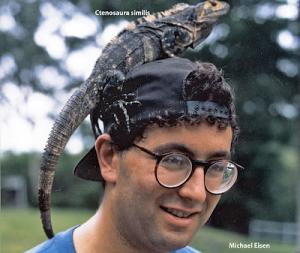On science blogs this week: Junk
ON THE ENCODE PROJECT AND HUMAN DNA: THE REAL ISSUES. Despite what you may have heard in the past few days, it's not really news that lurking in the 98.5% of our DNA that doesn't code for proteins is DNA that is not just active but essential. That truth has long been known (although not, apparently, by some science writers).
The real news is that there is plenty of scientific dispute over just how much of that 98.5% is crucial. But you wouldn't know that the percentage of working DNA was even an issue if it weren't for bloggers, many of them scientists.
First, the ostensible news this week — another candidate for the top science story of the year. That's the claim that that 80% of the human genome is definitely doing stuff. The other 20% is quite possibly doing stuff too; the 80% claim is based on analysis of only 147 types of human cells, but we've got thousands.
Still, those 147 cells yielded a torrent of papers published this week under the aegis of ENCODE (the Encyclopedia of DNA Elements). (Nearly all the papers are available free at a Nature portal.) This is really big Big Science, with hundreds of authors and at least three dozen papers scattered over several journals. Massive as this week's publishing project is, it's first steps, baby steps toward describing some of the stuff going on in the 98.5%.
So, what stuff is our 10 feet of DNA doing? In his magisterial summary at Not Exactly Rocket Science, not to be missed, Ed Yong presents this nutshell:
It contains docking sites where proteins can stick and switch genes on or off. Or it is read and ‘transcribed’ into molecules of RNA. Or it controls whether nearby genes are transcribed (promoters; more than 70,000 of these). Or it influences the activity of other genes, sometimes across great distances (enhancers; more than 400,000 of these). Or it affects how DNA is folded and packaged.
Yong quotes a few naysayers and cavillers. Here are some others:
His blog is called "it is NOT junk." So of course evolutionary biologist Michael Eisen deplores the near-universal presentation of the ENCODE project in the media as overturning a claim by scientists that noncoding DNA is junk. The junk analogy was abandoned a decade ago, he says. (I think so too, but then I've been writing a lot about epigenetics, so I would think that.) Eisen also deplores the exceptionally well-oiled PR machine accompanying the ENCODE work and critiques the chief press release. And he eviscerates Gina Kolata's New York Times story.
Speaking of evisceration, Eisen gets subjected to some by biochemist Larry Moran at Sandwalk. Moran claims 90% of human DNA is junk, although he discusses no specifics. Moran also ran an irresistable photo of Eisen, reproduced here. Lest the photo give you the wrong idea of Eisen's research interests, he is actually a fly guy, and a microbe guy too.
In an earlier post Moran trashed Yong's post but didn't really spell out his objections for those of us who are a little shaky on what exactly pseudogenes are or why exactly the creationists are going to love ENCODE in particular, in contrast to other research they seize on and misread (and misstate) to suit their ideology.
Faye Flam, recently recruited to the Knight Science Journalism Trackers, advocates junking the junk metaphor on the sensible grounds that researchers abandoned it long ago. She lists some general-audience articles that are still employing it. Flam has appeared here before because she writes the swell blog Planet of the Apes, which bravely tackles evolution for the general public. In her Tracker post, she's a little less hard on Kolata than Eisen is, and likes pieces by Sharon Begley for Reuters and David Brown and Hristio Boytchev for the Washington Post.
Evolutionary biologist T. Ryan Gregory has a series of debunking posts at Genomicron. They include specific reasons not to buy the idea that nearly all noncoding DNA is doing something important and links to a long list of media takes on the ENCODE project. (HT Bora Zivkovic.)
At the Mermaid's Tale, evolutionary biologist Ken Weiss is also unhappy about the way the ENCODE findings have been presented, but he walks something of a tightrope, trying not to denigrate the science in general. Among his arguments against the idea that nearly all the genome does something important is one from evolutionary biology.
Which goes like this: If nearly all our DNA was essential, natural selection would have eliminated our species because mutations are common enough that every fertilized egg would contain lethal mistakes. But here we are, so selection must be "trivially small." Which means that noncoding DNA must be full of sequences that don't matter much and can mutate without harm to H. sap the species.
In the comments, Weiss's fellow Mermaid and evolutionary biologist Holly Dunsworth offers something of a defense of the junk DNA metaphor in presenting ENCODE findings to the public. Maybe, she says, the notion of junk DNA is so common that debunking it needs to be done repeatedly.
I expect better of io9 bloggers because, after all, they come from the future and should know. So I was planning to debunk George Dvorsky's junk-laden ENCODE post, itself incorrectly labeled "debunkery." I am happily spared the task because a number of the commenters got there first.
I want to move on to other topics even though there's much, much more blogging about ENCODE. Science writers and scientists had plenty of time to prepare, thanks to the unprecedented PR effort devoted to the ENCODE publishing phenomenon. It even included a special exhibit at London's Science Museum and, oddly, an aerial ballet. According to Nancy Wilkinson at the Wellcome Trust blog, the dancers, representing proteins, were wrapped in twists of silk, representing DNA. Note that the silk was twisted clockwise, just like DNA.
BLOGGING AT DISCOVER MAGAZINE. I've been traveling for several weeks. While I was away it was announced that Kalmbach Publishing Co., which bought the science mag Discover a couple of years ago, will be closing the magazine's New York offices and moving operations to Kalmbach's home base in Waukesha, WI. This will save a lot of money, but apparently none of the current staff will be moving with it to Wisconsin. Inevitably the magazine will change.
For my purposes the interesting question is what will become of the splendid Discover blogging network, which comprises blogstars like Carl Zimmer and Ed Yong and Phil Plait and Sean Carroll (the physics one) and apologies to those I've unwittingly left out. According to Paul Raeburn's post at the Knight Science Journalism Tracker, Kalmbach is saying nothing will change.
Pfui. Shifts of this magnitude always always always mean change, usually dramatic change. On the face of it, Kalmbach would be crazy to do anything to drive away or damage the Discover bloggers, all of whom could jump to other salivating pubs in a trice and are surely crucial to pulling in readers. OTOH, those are nonpaying readers. As Discover's cost-saving relocation demonstrates, Kalmbach has the same problem as all other periodical publishers: how to continue to provide content, especially excellent content, while also making money. So far, few of them have solved it.
THE END OF JONAH LEHRER. The accusations against the celebrity science journalist Jonah Lehrer — that he recycled his work, and stole some of it from other writers, and sometimes just made things up — have reached a terminus of sorts. Wired, long home to his high-profile neuroscience blog Frontal Cortex, commissioned a report on Lehrer's record as a blogger, and the news was not good.
The assignment to vet a selected sample of 18 Frontal Cortex posts went to Charles Seife, science journalist and science journalism prof. Wired, oddly, didn't publish Seife's results, coming up instead with a statement by the editor-in-chief, Evan Hansen. He said there seemed to be no problem with Lehrer's articles for the magazine, which were fact-checked in the usual way. About the Frontal Cortex posts Hansen said
We will annotate the affected posts on Wired.com. In addition, all Frontal Cortex articles will carry a notice indicating some work by this author has been found to fall outside our editorial standards, along with a custom feedback link for suggestions, comments or further questions. We will try to follow up as appropriate on new information. Also, going forward, we will spot check random Wired.com articles for similarities with previously published material before posting them.
Fortunately we are privy to Seife's findings because he wrote about them in Slate and also was interviewed about them at length by Julie Moos at Poynter. There's a table of his findings at Slate, and the bottom line is that he found problems in all but one of the 18 posts.
Nearly all contained recycled material, sometimes referred to as self-plagiarism. As I have written here before, recycling strikes me — and some other journalists — as acceptable, at least sometimes. If you specialize in particular topics (as all of us do), you will inevitably recycle ideas and points of view at least, and probably also the occasional turn of phrase. Even if you're trying not to. And if you do it consciously, it is perfectly legitimate if you employ one of a number of ways to let the reader know that.
I don't agree, as Seife argues, that journalists have an unwritten compact with the reader to produce only fresh material. Especially these days, when everything you write is going to a niche audience, who the devil is "the reader?" Nobody except your mom is going to read everything you write, and even she may be too busy running a company.
OTOH, there are limits. Seife found recycling in 14 out of the 18 blog posts. The 18 were not, apparently, a random sample of the hundreds of posts Lehrer has produced; at least some had been selected as suspicious. At first glance, though, 14/18 is over the top.
And there's nothing arguable about the other transgressions Seife found: altered quotes (4/18), lifting uncredited material from press releases (5/18), plagiarism (3/18), making things up (4/18).
The Lehrer tale has spawned a lot of analysis over the summer, but two of the best pieces are recent, the result of Seife's analysis.
At Neuro Times, neuroscientist Stephen Casper is annoyed that folks ever took Lehrer seriously in the first place. Casper argues that Lehrer misled credulous would-be hipsters by misreading and misinterpreting and oversimplifying difficult neuroscience research. He also regards Lehrer as emblematic of the dishonest times, saying
Maybe we should hold Lehrer accountable. Perhaps. I don’t think the rules of blogging, the practices of journalism, science and medical publishing, or historical writing have really been caught up to the realities of the digital age.
Given the topic, I can't resist the lure of deliberate recycling. Call it by a sciencey term: adaptive reuse. A few weeks ago I argued that part of the problem is pressure on writers.
It comes from trying to write terrifically sexy, startling stuff too fast and too much ... When impossibly pressed for time and probably short on sleep, it must be pretty easy to slide into making things up and lifting material from elsewhere. It is actually a pragmatic move. There's quite a good chance he [the writer] won't get caught, or that's what he tells himself. And until recently it's been true.
So don't miss David Berreby's long, thoughtful post at Mind Matters. He expands on a related point, one that Seife makes briefly, that the absence of traditional publishing backstops — fact-checking and layers of editors that can catch problems before they get out there — encourages misbehavior. But Berreby's take is that this is the fault of publishers, who want great content on the cheap.
Or even better, free.
Which most blogging is. Alas.






